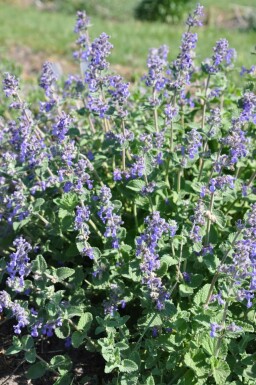
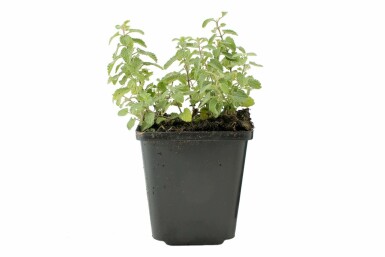
50cm


Updated on 10 September 2025
We regret to inform you that we are currently unable to ship orders to the United Kingdom. We anticipate being able to resume shipments at the beginning of 2026.
Nepeta is a versatile plant perfect for dry borders and prairie gardens, offering drought tolerance and long flowering periods. Its aromatic foliage attracts bees and butterflies, making it an excellent choice for natural gardens and insect corners, enhancing ecological diversity.


50cm


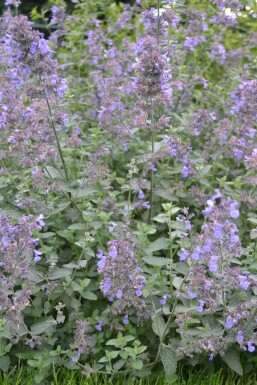
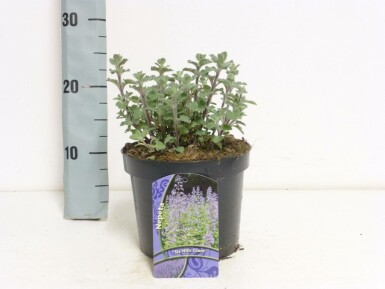



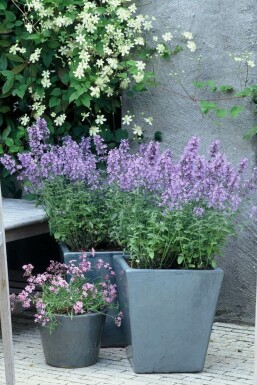
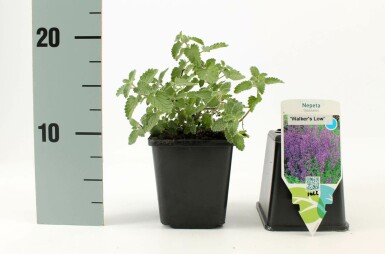



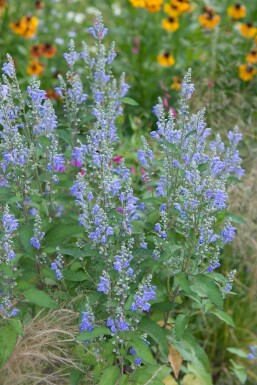
90cm



Nepeta is a popular choice for gardeners who appreciate its beauty and resilience. Known for its long blooming period from May to September, it features square gray-green hairy stems and aromatic leaves. The lavender-blue lip flowers grow in spikes, attracting bees and butterflies. This makes it an excellent addition to bee and butterfly gardens. Its scented foliage and drought-tolerant nature make it ideal for dry borders and fragrant borders. Many seek to buy Nepeta in the UK to enhance their outdoor spaces. This pollinator plant not only adds colour but also supports garden biodiversity. Discover why Nepeta catmint is a favourite among those who wish to cultivate a vibrant garden.
Nepeta, often known as catmint, is a delightful plant that adds charm to any garden. With aromatic leaves and long-lasting blooms, it is beloved for attracting pollinators like bees and butterflies. Synonyms for Nepeta include catmint, Nepeta flower, bee favourite, and border filler. In gardens, it is popular for borders, group plantings, pots, planters, natural gardens, and insect corners. Nepeta is part of the Lamiaceae family, originally from Europe and Asia. Known for its hardiness, it thrives in various climates and regrows quickly after pruning. Catmint is celebrated not only for its beauty but also for its ecological role, as it is rich in nectar and attracts bees and cats with its scent. The name "catmint" comes from the Latin name for the city of Nepete and is mythologically linked to protection and joy. Suitable for UK gardens, Nepeta can withstand drought and offers fragrant foliage. For those wanting to enhance their garden with a pollinator plant, buying Nepeta is a great choice.
Nepeta is a perennial plant that grows with an airy and ground-covering form. It is known for its gray-green hairy stems and aromatic leaves. As it matures, Nepeta develops into a soft mound shape, often forming a beautiful border or natural garden feature. It spreads quickly and is tolerant of drought conditions, making it a versatile choice for various garden settings. Nepeta begins its life cycle with quick regrowth after pruning, often attracting bees and cats. The development from its initial sprouting to a fully mature plant takes time, but its hardy nature ensures it thrives with minimal care. It grows well in pots and planters, adding a touch of nature to any space. The blooming period for Nepeta spans from May to September. Various factors, such as climate, temperature, and soil care, influence its bloom. Older plants tend to bloom more profusely, particularly when the soil is well-prepared and maintained. The flowers of Nepeta are usually purple-blue, lavender, or white, varying by species. The colour intensity can be affected by the plant's age, soil conditions, and exposure to light. Proper care enhances the vibrancy of these blooms, which are a delight to see. Nepeta is renowned for its aromatic scent, which comes from its leaves and is most intense during blooming. This fragrance adds to its appeal in the garden, attracting both pollinators and cats. The mature height of Nepeta varies significantly, ranging from 20 cm to 100 cm, depending on factors like species, location, and care. The Nepeta is an aromatic garden plant much loved by bees.
Nepeta, with its grey-green, aromatic leaves, brings a unique charm to any garden. The lanceolate shape and slightly hairy texture of its leaves help reduce evaporation, making it well-suited for dry conditions. In winter, Nepeta retains its foliage, although some varieties may lose leaves in colder climates. Known for its hardiness, Nepeta thrives in USDA zones 5 to 6, enduring temperatures as low as -29°C. Despite its winter resilience, protection from harsh winds and ensuring well-drained soil can enhance its frost tolerance. This plant is a valuable addition as it blooms profusely from May to September, attracting bees and supporting biodiversity in gardens. Nepeta's non-toxic nature makes it safe for gardens with children and pets. Its adaptability to heat and drought is significant, thanks to its hairy leaves and deep root system. The plant requires minimal water once established, making it ideal for low-maintenance gardens. As a herb garden favourite, Nepeta impresses with its lavender-like foliage and purple flower spikes, creating striking border fillers. Growing Nepeta faassenii UK is popular for edging due to its durability and aesthetic appeal. Overall, Nepeta enhances the garden's ecosystem, offering food and shelter for beneficial insects, thus promoting a balanced environment.
Nepeta is a versatile plant that can enhance a garden in numerous ways. It is highly valued for its scented foliage and ability to attract pollinators like bees and butterflies. Here are some effective ways to incorporate Nepeta into your garden:
Nepeta is a wonderful choice for gardens with dry borders or fragrant borders. It pairs beautifully with several other plants, creating a harmonious and colourful display. Combining Nepeta with Salvia can enhance the garden's visual appeal, as both share similar growing conditions and attract pollinators. Another great companion is Achillea, offering a contrast in texture and a variety of bloom colours. Lavandula can be included to add fragrance and complement Nepeta's long blooming period. Coreopsis and Echinacea also make excellent partners, adding vibrant colours and height variations. These combinations work well because they all thrive in sunny spots and have similar water needs, making them drought-tolerant. Moreover, Nepeta has a long flowering period and is an ideal edge plant in a border with perennials. The mix of textures, heights, and colours ensures a dynamic and lively garden setting. Nepeta (Catmint) not only adds beauty but also attracts bees, making it beneficial for pollinator gardens. Choose these plant companions for a garden that is both visually pleasing and environmentally friendly.
Nepeta thrives in full sun to light shade, needing at least 4-6 hours of sun daily. Too much shade affects its growth and flowering. It's important to provide a location with well-drained soil to prevent root rot. Nepeta handles wind well, but using windbreaks like hedges can offer extra protection. Ideal soil for Nepeta is calcareous and well-drained, supporting its drought-tolerant nature. Regular fertilising enhances growth, especially in the growing season. Soil moisture should be dry to moderately moist; too much water can be harmful, especially in clay soils. The pH preference for Nepeta is slightly alkaline, favouring conditions that promote healthy root development. Ensuring these conditions will help maintain a lush, flowering plant. Planting in borders, Nepeta adds beauty with its scented foliage and serves as a pollinator plant, attracting bees. Consider adding this drought-tolerant fragrant perennial to the garden for a vibrant and beneficial landscape feature.
Planting Nepeta can be done in spring or late summer when conditions are dry and sunny. Container-grown plants can be set anytime except during frost, while balled plants are best in spring and autumn. The right planting distance depends on the plant type and expected growth. Check the Heijnen product page for specific recommendations about plants per metre. Soil preparation is crucial; use well-draining, calcareous soil with moderate fertility. Heijnen planting soil is recommended for best results. Full sun exposure is essential, avoiding heavy and wet soils. Start with thorough watering post-planting and maintain regular watering until established. Fertilisation during the growing season promotes health and flowering. Pruning can encourage repeat blooms, and the plant's drought tolerance makes it suitable for sunny borders. Catmint, known for its scented foliage, is also a favourite bee plant. Its greyish leaves help reduce evaporation, perfect for drought-tolerant borders. Ensure at least 4-6 hours of sunlight daily for vibrant growth.
Nepeta, also known as catmint, is loved by bees and looks beautiful in borders. Proper care ensures it blooms from May to September. Here are some tips for maintaining healthy Nepeta plants:
Nepeta is a perennial that quickly regrows after pruning and attracts both bees and cats. For garden enthusiasts, it is a delightful addition to any border as a bee favourite and border filler. For those looking to enhance their garden, consider buying catmint, also known as Nepeta.
Nepeta brings charm to any garden with its beautiful flowers and aromatic leaves. Known for its purple-blue and lavender blooms, Nepeta creates a stunning display from spring to autumn. This plant's scent draws butterflies and bees, making it an essential addition to any pollinator garden. The foliage, often grey-green or blue-green, adds texture and colour contrast. As a drought-tolerant perennial, Nepeta is a tough yet graceful choice for borders and dry areas. Its airy growth form covers the ground beautifully, offering visual delight and functional benefits. Nepeta is a fragrant butterfly plant and cat favourite. During autumn, its leaves may bring subtle changes in colour, enhancing the seasonal transition in the garden. Nepeta catmint bee plant enriches garden life by providing shelter and food for various creatures. It's versatile enough to serve as a border filler, thriving in fragrant and bee gardens. Long blooming and with scented foliage, Nepeta is perfect for dry borders, where its low-maintenance nature shines. This plant is a true garden ally, blending beauty with ecological benefits, making it a drought-tolerant border plant ideal for any garden setting.
Nepeta, also known as catmint, is a popular choice for many gardens. This hardy plant is not only beautiful but also offers several benefits.
Advantages:
Disadvantages:
Nepeta, with its beautiful blue-violet flowers, is perfect for adding colour from May to September. Heijnen offers Nepeta known for its drought-tolerant nature and fragrant foliage. It's ideal for dry and fragrant borders, attracting bees and butterflies to your garden. The long-flowering season ensures a vibrant display, making Nepeta a top choice for bee and butterfly gardens. Nepeta is not only a favourite among insects but also has aromatic leaves that appeal to cats. This makes it a delightful addition to any prairie garden. Its resilience in different garden settings makes it a reliable choice for both novice and experienced gardeners. With easy maintenance, simply cut back after bloom to encourage fresh growth. Purchasing Nepeta ensures a stunning and wildlife-friendly garden. Heijnen provides high-quality plants, making it easy to buy Nepeta in the UK. Embrace the charm of this drought-tolerant fragrant perennial by adding it to your borders today. Order Nepeta (Catmint) from Heijnen and bring a fragrant sea of blue-violet flowers to your garden that attracts cats and bees.
We would like to provide some tips on how to plant and care for a Nepeta. By following these tips, you can be sure to enjoy your Nepeta for a long time.
Nepeta thrives in a sunny location with well-drained, dry soil. It's important to find a spot that receives at least 4-6 hours of sunlight each day. This environment supports better growth and flowering, with healthier foliage and stronger plants. Calcareous soil suits Nepeta well, helping it to grow lush and vibrant. The plant prefers dry conditions, making it suitable for dry borders or fragrant garden corners. Its greyish, hairy leaves minimise water loss, ideal for drought and pruning. Planting in spring or late summer offers the best start, ensuring robust growth. Regular pruning after blooming encourages further flowering, leading to a richly coloured display. Nepeta is perfect for borders, group plantings, or pots, contributing to bee and butterfly gardens. The right spot is essential for Nepeta's successful growth and beautiful bloom.
Preparing the soil well is key before planting Nepeta. This enhances plant growth by improving drainage, providing nutrients, and adding organic matter like compost. Proper soil preparation ensures that the soil is loose enough for roots to spread and access water and nutrients. For Nepeta, use calcareous, well-drained soil in a sunny spot. Pot-grown plants can be planted year-round, except during frost. If available as root ball plants, plant in spring or autumn without removing the jute sack. It’s essential to water Nepeta immediately after planting and continue until they are well-established. The size of the plant determines how many can be planted per square metre. Optimal spacing allows each plant adequate room to grow. Catmint is a bee-friendly, drought-tolerant choice, thriving in full sun and offering long-lasting blooms.
Nepeta, commonly known as catmint, benefits from timely fertilisation to ensure healthy growth and vibrant blooms. While this plant typically has a low need for fertiliser, a light feed in spring can enhance its vitality and longevity. Using an organic or organic-mineral fertiliser from Heijnen is recommended as it supports good growth, rich blooms, and overall plant health. Fertilising should occur twice a year: once in spring and again in summer. The amount of fertiliser depends on the plant's size, with larger plants requiring more. It is crucial to ensure that fertilisers penetrate the soil through rain or watering, as this helps release nutrients for root absorption. During dry spells, it is advisable to water the garden after fertilising to activate the nutrients. Consistent care will keep Nepeta flourishing in borders, group plantings, pots, or natural gardens.
Nepeta is an excellent plant for gardens. It should be pruned regularly to keep it healthy and promote new growth. Cutting back Nepeta after the first bloom in July can encourage reblooming. Pruning also helps maintain the shape of the plant and prevents it from becoming too large. For best results, remove any old shoots and leaves in spring. This not only tidies the plant but also makes room for fresh growth. Use sharp secateurs for clean cuts, which are important to avoid damaging the plant. Good tools are essential for effective pruning and to ensure the plant thrives. Prioritising these pruning techniques will keep Nepeta looking its best and improve overall garden aesthetics. By following these tips, Nepeta will continue to be a favourite flower in the garden.
Nepeta requires little water compared to many other plants. It's important to let the soil dry out between waterings, as Nepeta prefers dry conditions. When planting new Nepeta flowers, ensure they receive adequate water initially to help them establish roots. Once settled, these plants typically need water only during extended dry spells. It's better to water thoroughly rather than giving small amounts daily. The best time to water is early morning or late afternoon, reducing water loss through evaporation. Always check the soil for moisture levels to avoid unnecessary watering. Proper drainage is crucial; excess water should flow away freely, whether in the ground or in pots. Drip irrigation systems work well for rooted plants but require supplementary watering when Nepeta is newly planted. Known for high drought tolerance, Nepeta thrives with minimal care in dry environments.
Nepeta is a lovely addition to any garden, known for its lavender-like foliage and aromatic purple flower spikes. This drought-tolerant plant is a favourite among bees and butterflies, offering long-lasting blooms that brighten up borders. Named after the city of Nepete, it carries mythological ties to joy and protection. Importantly, Nepeta, also known as catmint, is non-toxic, making it safe for children and pets. Its fragrant foliage is perfect for herb gardens, adding both visual and sensory delight.
Nepeta, commonly known as catmint, benefits from dividing every 3 to 4 years. This process rejuvenates the plant, helps manage its size, and removes old parts. To divide, dig up the plant carefully, ensuring roots are not damaged. Separate the young parts, discarding woody sections, and replant the healthier portions. The best time for this is in the autumn, as the cooler temperatures support new growth without causing stress. Divide using a sharp spade or garden knife, ensuring clean cuts for healthy regrowth. Regular division promotes vibrant flowering and maintains plant health, enhancing the overall look of the garden.
Catmint offers delightful purple-blue blooms and aromatic grey-green leaves, perfect for adding charm to any garden. This drought-tolerant perennial thrives from May to September, providing a long flowering season. Ideal for borders, its fragrant foliage attracts bees and butterflies, enhancing the garden's ecological value. Bring your garden to life with catmint's unique beauty. Order Nepeta (Catmint) from Heijnen and enjoy a vibrant display.
